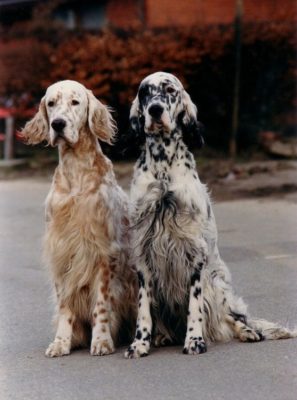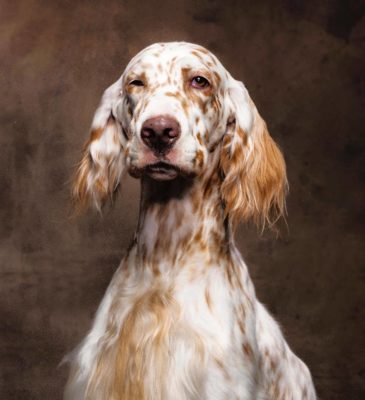English Setter
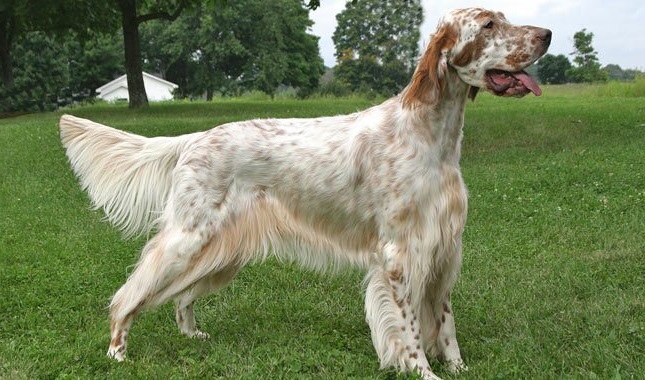
If previously the English Setter was only seen in the company of a hunter, today the dog has earned the title of a loyal friend and companion. The main characteristic of the Laverack is its sharp mind, good-naturedness, and sociability. English Setter can not spend a second without the owner. The breed is very contactable and needs constant communication.
Table of Contents
Breed Information
| Another Name | Lawerack, Laverack, Llewellin (or Llewellyn) Setter, Ryman-type (or Old Hemlock) Setter |
| Origin | England |
| Height | Males 65-68 cm Females 58-63 cm |
| Weight | 21-35 kg |
| Fur | Long |
| Color | One-color, two-color, and three-color with shabrack (brown, orange, lemon, black) |
| Lifespan | 10-12 years |
| FCI Classification | Pointing Dogs |
| Group | Hunting dogs |
| Price | From $200 |
Breed Photos
Origin History
For many years, cynologists of different countries have been arguing about which breed preceded the English Setter. Some argue that it is related to Spanish dogs. Some believe the English Setter is descended from spaniels. One thing is certain – the English Setter is a 100% English breed, regardless of its ancient roots.
As early as the 14th century, English Setters were thought to be setter spaniels, used by local hunters in Great Britain to hunt feathered game. The breed got this name because of its ability to freeze on the spot at prey’s sight. In English, “to sit” means “to freeze” or “to make a stand”. Later the breed became of interest to Edward Laverack, credited with the English Setter’s look and working qualities. He used a system of line-breeding, which helped him to improve the breed. Laverack wanted to get a real noble dog with a gorgeous exterior and an incredible zeal for hunting.
Since 1825 Laverack has been breeding and selecting for the breed that is still so popular today. In 1859, he first presented English Setters at the exhibition, where they immediately won many hunters’ hearts. Also for the English Setter was forever fixed for the name of its creator – Laverack. In 1890 the first club of fans of the breed was founded in Great Britain. The official standard of the breed was changed several times. Now the standard of the Fédération Cynologique Internationale from 2009 is used. The English Setter remains the most popular legal dog and is valued by hunters around the world.
Appearance
The founder of the breed worked hard on what an English Setter should look like. It is not for nothing that the Laverack is called a real gentleman in the breed’s home country. The dog looks incredibly statuesque and has a unique appearance. By its nature, the English Setter is noble and is considered a professional hunter.
According to the standard, it is a medium-sized, rather elongated dog. The physique is very harmonious. The head is elongated, the transition from forehead to muzzle smooth. The eyes are not deep, rounded, dark in color. The look is concentrated and attentive. The ears are soft and floppy, set in parallel to the eyes and touching the cheekbones. The neck is strong; an excessively thick neck is considered an aberration. Deep chest. The abdomen is taut. The limbs are long and muscular.
The English Setter has a graceful gait and easy movement. The tail is medium length, saber-shaped, and continues the backline. The coat is soft to the touch, long, and can form a comb-over. There is especially a lot of hair on the rear surface of the paws, ears, lower chest, and tail. Acceptable Colors:
- single-color (steel or white);
- bicolor (white with a blue tint, liver-white, black and white, mottled white);
- tricolor (orange and black spots on white tone, white with papal and mottled).
Character
If previously the English Setter was only seen in the company of a hunter, today the dog has earned the title of a loyal friend and companion. The main characteristic of the Laverack is its sharp mind, good-naturedness, and sociability. English Setter can not spend a second without the owner. The breed is very contactable and needs constant communication. The Laverack is also patient and active, which means it won’t mind spending time with your child.
There are no guarding qualities – an English Setter is too kind and won’t be able to protect your home. He is more likely to jump into a stranger’s paws to play with him. Its attitude to other animals is balanced; hunting instinct shows only to birds and rodents. Keep in mind that the breed is extremely active and needs long walks and exercise.
Care
The main point in caring for an English Setter is to take care of its hair. It is long, tangled, and tends to form characteristic frizzes. Comb the hair every week with a special brush, or, better yet, buy a glove-brush with rubber teeth. It is ideal for silky and unruly Laverack hair.
Frequent water treatments are not necessary – they can make the coat stiff. It is enough to bathe your pet no more than once every three to four months. Also, pay attention to your pet’s ears – clean them twice a week to prevent inflammation. Claws usually clip themselves, but if that’s not enough, trim them every month.
Training
When it comes to training, the English Setter, like most legal dogs, can be stubborn. Owners note the Laverack’s disposition to training only if the dog trusts the owner completely. The setter’s high intelligence, good memory, and quick reflexes will help you in his training. Don’t forget that the Laverack is a proud dog and will remember aggression in his direction. Be more patient, as abuse will make even the most well-mannered dog an unmanageable and vicious animal.
Common Diseases
The health of the English Setter is quite strong. However, the risk of some hereditary diseases has not escaped the breed:
- deafness;
- atopic dermatitis;
- hip dysplasia;
- eye diseases (eyelid eversion, retinal atrophy, blindness).
Nutrition
If you have the time and can prepare food for your pet yourself, the diet should include lean meat. As well as healthy carbohydrates and fiber. Be sure to add essential vitamins during the molting period.
An interesting characteristic of the breed is that English Setters are very fond of cheese. Sometimes you can use cheese as a treat when encouraging during training. Dry food for medium breeds of premium quality is also suitable for the Laverack.
 Saint Miguel Cattle Dog
Saint Miguel Cattle Dog Spinone Italiano
Spinone Italiano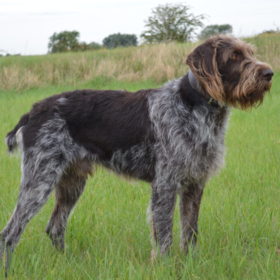 German Roughhaired Pointer
German Roughhaired Pointer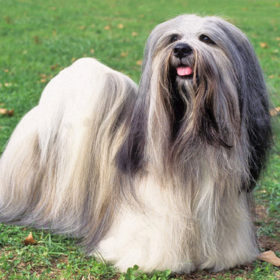 Lhasa Apso
Lhasa Apso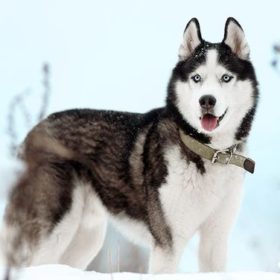 Siberian Husky
Siberian Husky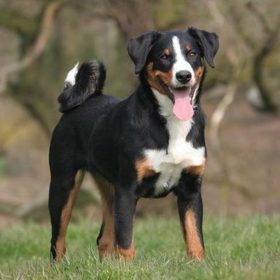 Appenzeller Sennenhund
Appenzeller Sennenhund